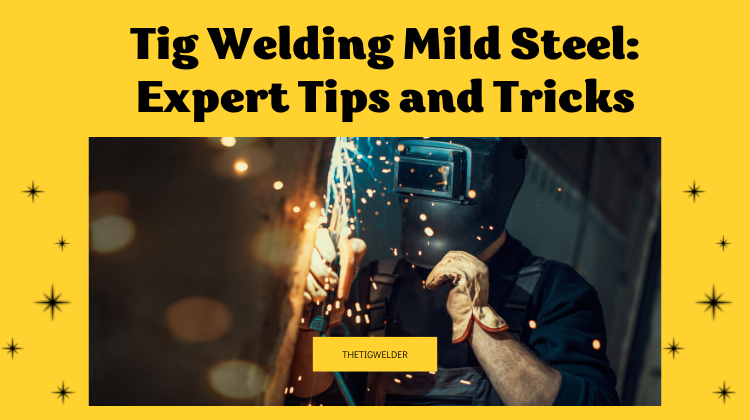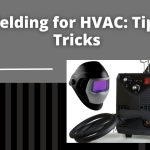Mild steel is a popular choice for TIG welding due to its versatility and ease of use. However, TIG welding mild steel can still present challenges, and it’s important to follow certain tips and tricks to ensure that your welds are strong and high-quality. Whether you’re a beginner or an experienced welder, these tips can help you achieve success in TIG welding mild steel.
Tig welding, also known as tungsten inert gas welding, is a popular mild steel method. It is a precise and highly skilled process that requires the welder to have a steady hand and good control over the welding torch. One of the benefits of tig welding mild steel is that it allows for a clean and aesthetically pleasing weld, as it does not produce as much spatter or slag as other welding methods.

Tig Welding Mild Steel
Following a few expert tips and tricks is important to achieve successful tig welds on mild steel. These include properly preparing the materials, selecting the correct filler metal and tungsten electrode, and maintaining proper torch technique. Following these guidelines, you can produce strong, high-quality welds on mild steel using tig welding.
Choose The Right Tig Welder And Settings
One of the first steps in successful TIG welding of mild steel is choosing the right TIG welder and settings. It’s important to select a welder with an appropriate amperage range for the thickness of the material you will be welding. Using a foot pedal or hand control to adjust the arc’s heat can also be helpful, as it allows for precise control and can help prevent warping and distortion.
Regarding the type of TIG welder, mild steel can be welded using either an AC or DC TIG welder. AC TIG welders are typically used for aluminum and non-ferrous materials, while DC TIG welders are better suited for mild steel and other ferrous materials. However, AC TIG welders can still be used for mild steel as long as the appropriate amperage range and settings are used.
Use The Right Filler Rod
Using the right filler rod is another important factor in successful TIG welding of mild steel. It’s important to match the alloy of the filler rod to the base material to ensure that the weld is strong and has the same properties as the base material. It would help if you also considered the thickness of the material, as different filler rods are better suited for different thicknesses.
Clean The Base Material
Before TIG welding mild steel, it’s important to clean the base material to remove any oxide or contaminants. This can be done using a wire brush or grinder. Cleaning the base material helps to ensure that the weld will be strong and free of defects.
Use Proper Technique
Proper technique is crucial when TIG welding mild steel. Keep the tungsten sharp and clean to ensure a consistent arc and a strong weld. Use a long, sweeping motion with the torch to avoid overheating the material and causing warping or distortion. Maintain a consistent arc length to ensure the weld is even and strong. It’s also important to use the correct travel angle, as this can impact the strength and appearance of the weld.
Use Proper Shielding Gas
To ensure a successful TIG weld on mild steel, it’s important to use the proper shielding gas. Argon is the most commonly used gas for TIG welding mild steel, as it helps to protect the weld from contamination and provides a stable arc. Use a high-purity grade of argon for best results.
Practice Proper Post-weld Cleaning
After TIG welding mild steel, it’s important to clean the weld to remove any oxide or contaminants. A wire brush can be used to remove any oxide from the weld, and a mild steel-specific cleaner can be used to remove any residue. Proper post-weld cleaning helps to ensure that the weld is strong and corrosion-resistant.
Consider Using A Backing Strip
When TIG welding thin materials or welding in a flat position, using a backing strip can help prevent warping and distortion. A backing strip is a thin material placed behind the weld joint to support and prevent the material from sagging or warping.
How do you weld mild steel with TIG?
TIG welding mild steel involves using a non-consumable tungsten electrode in combination with a welding torch and filler metal. With TIG welding, the tungsten electrode is pointed and heated with an electric arc to create a molten weld pool. The filler metal is then melted and added to the weld pool to create the weld joint. The weld joint is cooled, and the welded joint is inspected for defects.
How Can I Get Better At Tig Welding?
To become a better TIG welder, it’s important to practice regularly. Consider enrolling in a welding class or an apprenticeship program to learn the basics and hone your technique. You can also practice on scrap metal or purchase a TIG welder and practice at home. It’s also important to use the correct settings for the material you’re welding. Practicing various metals and settings can help you become a more experienced TIG welder.
What Should You Not Do When Tig Welding?
When TIG welding, you should always wear the appropriate safety gear, such as a welding helmet, gloves, and long-sleeve shirt. It would help if you never looked directly at the arc or the weld pool and always used the correct amperage and filler metal for the material you’re welding. It would help if you never touched the electrode with your bare hands, as it can cause injury.
Why Are My Tig Welds Not Shiny?
The shininess of a TIG weld depends on several factors, including the type and size of the filler metal, the amperage settings, and the technique used. If the amperage settings are too low, the weld will appear dull or “greyish.” In addition, if the technique is not correct, the weld may appear dull or rough. The weld may appear grainy or porous if the filler metal is too small. The amperage settings, technique, and filler metal should all be correct to achieve a polished, smooth weld.
How Do You Make A Tig Weld Colorful?
TIG welding can create colorful welds using a filler metal with a color tint, such as copper or bronze. The color of the weld will depend on the type of filler metal used and the amperage settings. Copper and bronze are the most common colors in TIG welding, but other colors can be achieved with different filler metals. Additionally, you can use different amperage settings to create a range of colors.
Conclusion
By following these tips and tricks, you can increase your chances of success in TIG welding mild steel. Choosing the right TIG welder and settings, using the right filler rod, cleaning the base material, using the proper technique, using the proper shielding gas, and practicing proper post-weld cleaning are all important factors in achieving strong, high-quality welds on mild steel. Remember to also consider using a backing strip if needed. Paying attention to these details ensures that your TIG welding projects on mild steel successfully meet your desired results.

It’s been years since I got into welding as a side hustle. It’s been so long since Doing All kinds of welds for business and pleasure as this is my hobby. Being in this field I have learned from hands-on-experience also came to know what gears work and what doesn’t. The Tig Welder is my own platform where I use to share my experience.






Leave a Reply